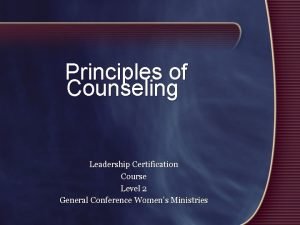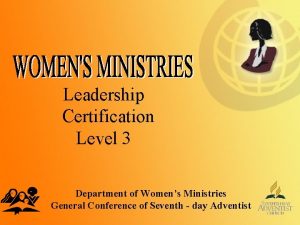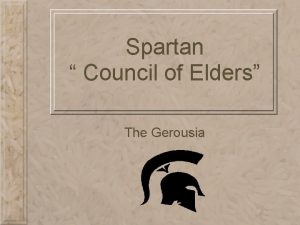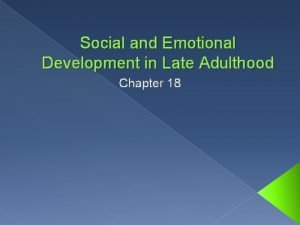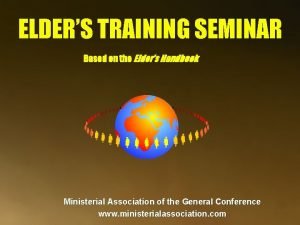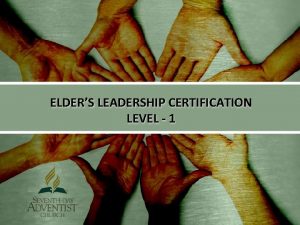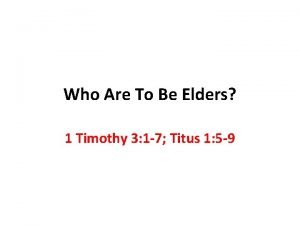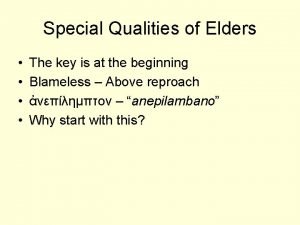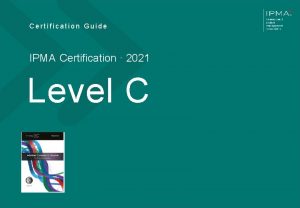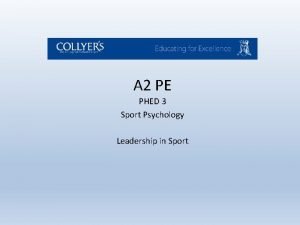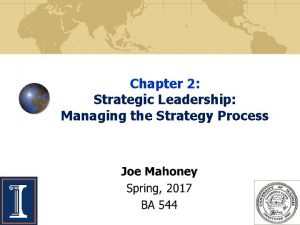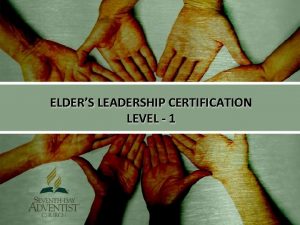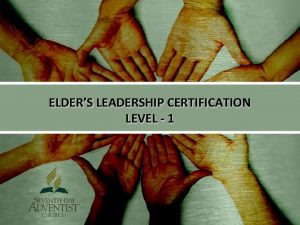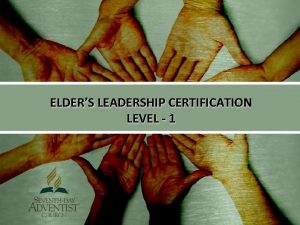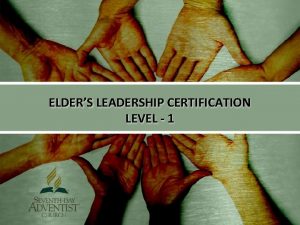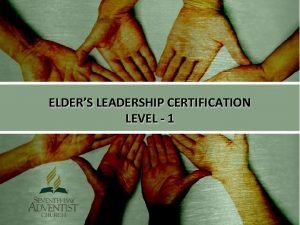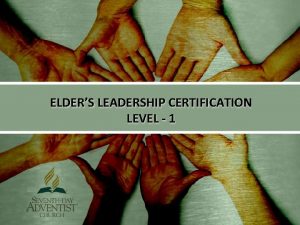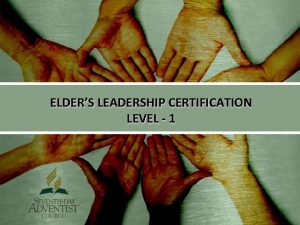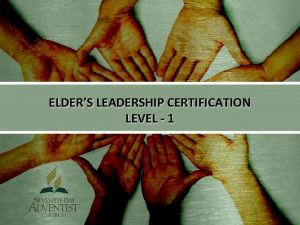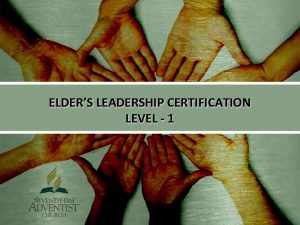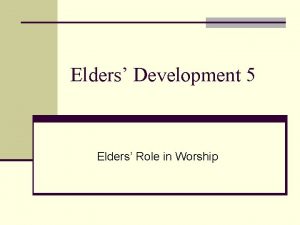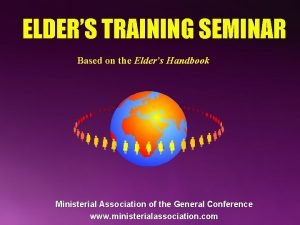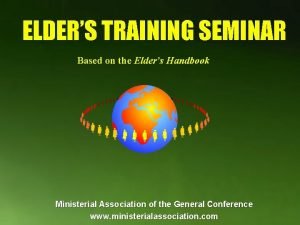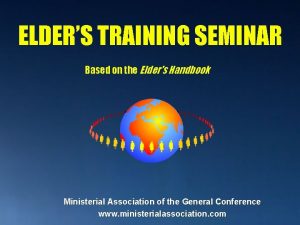ELDERS LEADERSHIP CERTIFICATION LEVEL 1 How to Prepare






















- Slides: 22

ELDER’S LEADERSHIP CERTIFICATION LEVEL - 1

How to Prepare a Sermon

What is the PURPOSE of a Sermon? 1. Proclaim the Good News of salvation. 2. Lead people to Christ. 3. Make disciples. 4. Help people apply the Word of God in their lives. 5. Allow God to speak and minister to people.

What is the PURPOSE of a Sermon? MAIN OBJECTIVE Changing lives is the ultimate purpose of a sermon.

TYPES OF SERMONS 1. Topical or Textual Sermon a. List Outline b. Argument 2. Expository Sermon 3. Narrative Sermon

SERMON OBJECTIVES 1. Exegesis 2. Exhortation 3. Education 4. Evidences 5. Evangelism

THE TEXT • Prayer and guidance from the Holy Spirit will influence choice. • Carefully choose a Bible text or scripture passage.

The Needs of the AUDIENCE 1. Physical 2. Mental 3. Spiritual

CONSIDER THE AUDIENCE 1. Age 2. Sex 3. Special date or occasion 4. Marital status 5. Location 6. Profession 7. Will your sermon/talk need to be translated

Three Steps for Bible Text Analysis 1. Read the Bible Text: John 3: 16 “For God so loved the world that he gave his one and only Son, that whoever believes in him shall not perish, but have eternal life. ”

Three Steps for Bible Text Analysis 2. Note divisions: 1. 2. 3. 4. God loved the world. God gave His only Son. Whoever believes in the Son shall not perish. Whoever believes in the Son shall have eternal life.

Three Steps for Bible Text Analysis 3. Apply the Bible Text: • Read nearby verses or chapters. As you read, ask yourself: 1. What is useful in the text that the audience can apply to their lives? 2. How can this message be applied to my personal life?

Three Steps for Bible Text Analysis Interpret the Bible Text: • Who? • What? • Why? • When? • Where? • How?

WRITING THE SERMON 1. Introduction 2. Body 3. Conclusion

WRITING THE SERMON 1. INTRODUCTION 1. 2. 3. 4. Present Subject Catch Attention State Thesis Transition into Body of the Sermon

WRITING THE SERMON 2. BODY 1. 2. 3. 4. 5. Signal State Link Support Explanation (if necessary) 6. Illustrate

WRITING THE SERMON 3. CONCLUSION 1. Restate or summarize the main point of sermon 2. Focus on application 3. Ask for a decision 4. Result

WRITING THE SERMON ILLUSTRATIONS 1. Verify that they are appropriate 2. Do not try to fit yourself into the experiences of others 3. Use discernment with personal experiences

TITLE • To attract listener’s attention • To communicate the main idea of the sermon.

STUDY • Allow Time • Meditate

DELIVERY Notes: – Written draft – Brief sermon outline – Use half a sheet of paper – 14 point font – Leave space in margins and between lines – Underline important words or use colored highlighter

VERBAL, VOCAL, AND VISUAL • • Eye Communication Gestures and Facial Expressions Posture and Movement Dress and Appearance Voice and Vocal Variety Listener Involvement The Natural Self
 Women's ministries leadership certification program level 2
Women's ministries leadership certification program level 2 Women's ministries leadership certification program
Women's ministries leadership certification program West ga resa
West ga resa Gerousia
Gerousia Elders' housing preferences reflect a strong desire for
Elders' housing preferences reflect a strong desire for 24 thrones in heaven
24 thrones in heaven Bronson intranet
Bronson intranet Elders handbook
Elders handbook Certificate for church elders
Certificate for church elders Qualifications for elders 1 timothy
Qualifications for elders 1 timothy Qualities of elders
Qualities of elders Transactional leadership vs transformational leadership
Transactional leadership vs transformational leadership Adaptive leadership theory
Adaptive leadership theory Capable but cautious performer
Capable but cautious performer Ipma certificering
Ipma certificering Cjis network training v1 answers
Cjis network training v1 answers Leadership styles business a level
Leadership styles business a level Business level strategy differentiation
Business level strategy differentiation Strategic leadership
Strategic leadership Jim clawson
Jim clawson Chelladurai leadership model
Chelladurai leadership model Level 5 pyramid of strategic leadership
Level 5 pyramid of strategic leadership Prepare thy work without
Prepare thy work without
